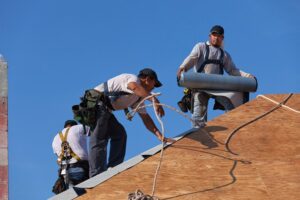
Installing a new roof for your commercial building is a significant investment. Over time, wear and tear can lead to damages that require roof replacement. Understanding the signs that indicate the need for a replacement is crucial to avoid further complications. Neglecting roof replacement can have a detrimental impact on the overall integrity of your building. Choosing the right roofing material is also a vital aspect of the process, as it determines the durability and longevity of the new roof. In this article, we will explore the different aspects of Cordova Commercial Roofing Replacement and provide valuable insights into the process.
Understanding the Need for Roof Replacement
Signs Your Commercial Roof Needs Replacement
As a responsible business owner, it’s important to be aware of the signs that suggest your commercial roof may need a replacement. One evident indication is recurring leaks, especially after heavy rainfall or storm events. Visible damages, such as cracks, blisters, or missing shingles, are also clear signs that your roof may be reaching the end of its lifespan. Additionally, if you notice extensive mold or mildew growth, it could be a result of water infiltration due to roof deterioration.
Moreover, another crucial sign that your commercial roof may need replacement is sagging or uneven areas on the roof surface. This could indicate underlying structural issues that compromise the safety and stability of your building. It is essential to address these issues promptly to prevent further damage and ensure the longevity of your property.
The Impact of Neglecting Roof Replacement
Neglecting roof replacement can have severe consequences for your building and your budget. Aging roofs can become susceptible to leaks, which can lead to water damage and compromised structural integrity. This can result in expensive repairs and potential hazards for your employees and customers. Furthermore, an outdated roof may not meet current building codes and regulations, making it necessary to invest in a replacement to ensure compliance and safeguard against legal liabilities.
Additionally, ignoring the need for roof replacement can impact the energy efficiency of your commercial building. An old or damaged roof may lack proper insulation, leading to increased energy consumption and higher utility bills. By investing in a new roof, you can improve the energy efficiency of your property, reduce operating costs, and create a more comfortable indoor environment for occupants.
Choosing the Right Roofing Material
Comparing Different Roofing Materials
When it comes to selecting the right roofing material for your commercial building, several options are available. Each material has its own unique characteristics and benefits. For instance, asphalt shingles are cost-effective and widely used due to their durability and ease of installation. On the other hand, metal roofs offer excellent longevity and energy efficiency, making them a popular choice for environmentally conscious businesses. Single-ply membranes, such as TPO and EPDM, provide superior waterproofing and can withstand extreme weather conditions.
Factors to Consider When Selecting Roofing Material
Choosing the right roofing material requires careful consideration of various factors. Firstly, it’s essential to assess the specific requirements of your commercial building, such as its size, location, and exposure to environmental elements. Additionally, consider the maintenance requirements, lifespan, and cost-effectiveness of each material. Consulting with a professional roofing contractor can provide valuable guidance and ensure you make an informed decision that aligns with your budget and long-term goals.
The Roof Replacement Process
Initial Inspection and Assessment
Before initiating the roof replacement process, a thorough inspection and assessment of your existing roof are necessary. This step allows experts to identify underlying issues and determine the extent of damage. They will evaluate the structural integrity, review the current roofing system, and assess any potential areas of concern. This information will guide the roofing professionals in planning the replacement process and selecting the appropriate materials and techniques.
Removal of the Old Roof
Once the initial assessment is complete, the next step is removing the old roof. This involves stripping off the existing materials, such as shingles, underlayment, and insulation. Proper precautions, including safety measures and disposal of debris, should be taken during this phase. Skilled roofing contractors will ensure that all old materials are removed efficiently and without causing any further damage to the building structure.
Installation of the New Roof
After the old roof is removed, the installation of the new roofing system can begin. This includes the application of underlayment, flashing, and the chosen roofing material. Experienced contractors adhere to manufacturer guidelines and industry best practices to ensure precision and efficiency during the installation process. Quality control measures are implemented to validate the integrity of the new roof and to address any potential issues before completion.
Cost and Time Considerations
Estimating the Cost of Roof Replacement
The cost of commercial roof replacement can vary depending on several factors, including the size of the building, the choice of materials, and the complexity of the project. It is advisable to obtain detailed quotes from reputable roofing contractors that outline the scope of work and associated costs. While cost is a significant consideration, it’s important not to compromise on quality. Investing in a durable and reliable roofing system will provide long-term value and reduce the risk of future repairs or replacements.
Timeline for Commercial Roof Replacement
The duration of a commercial roof replacement project depends on factors such as the size of the building and the complexity of the roof design. A professional roofing contractor will provide a detailed timeline that outlines the various stages of the process, from initial inspection to final completion. Factors such as weather conditions may also influence the timeline, as adverse weather may delay certain phases of the project. It’s essential to discuss the timeline with your contractor and plan accordingly to minimize disruptions to your business operations.
Maintenance Tips for Your New Roof
Regular Inspections and Maintenance
After investing in a new commercial roof, regular inspections and maintenance are crucial to maximize its lifespan and prevent potential issues. Engaging a professional roofing contractor to conduct periodic inspections will help identify any developing problems early on. Prompt repairs and maintenance, such as clearing debris and ensuring proper drainage, can prevent costly damages and avoid compromising the integrity of the new roof.
Preventing Common Roofing Issues
Implementing preventive measures can significantly reduce the occurrence of common roofing issues. Regular cleaning of gutters and downspouts helps to prevent clogging and water buildup, which can lead to leaks and water damage. Trim trees and branches that are close to the roof to minimize the risk of fallen debris. Additionally, conduct routine checks for any signs of damage, such as loose or missing shingles, and address them promptly to maintain the performance of the new roof.
In conclusion, Cordova Commercial Roofing Replacement requires careful consideration of various factors, from recognizing the signs that indicate the need for replacement to selecting the right roofing material. The process itself involves an initial inspection, removal of the old roof, and installation of the new roofing system. Cost and time considerations are essential, as is the implementation of regular maintenance and preventive measures. By following these guidelines, you can ensure the longevity and performance of your commercial roof, providing a secure and comfortable environment for your business and employees.
Ready to safeguard your commercial property with a roofing system that stands the test of time? Look no further than Commercial Roofing Rana, your trusted partner for top-tier commercial roofing services in the Mid-South region. With a legacy of excellence since 1983, our licensed professionals are committed to delivering the impeccable Duro-Last roofing solutions your business deserves. From industrial complexes to shopping centers, we’ve got you covered. Don’t let water damage threaten your investment. Schedule Now! and let Commercial Roofing Rana fortify your building with a durable, perfectly fitted new roof.
